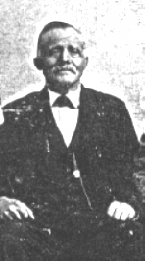The Captain
As told by Chris Kirkman
 When Danish longboat warriors conquered England, Ireland, Normandy and Sicily, the Danes in the Middle Ages they had a saying for their wanderings: they went “a-Viking.” There was a lot of Viking in Christian Wilhelm Kirkemann of Kalundborg. The tall, blond son of Neils and Ane Kirkemann left home at age 14 in 1842 and spent 10 years as a crewman on sailing ships that voyaged to the Mediterranean and South America.
When Danish longboat warriors conquered England, Ireland, Normandy and Sicily, the Danes in the Middle Ages they had a saying for their wanderings: they went “a-Viking.” There was a lot of Viking in Christian Wilhelm Kirkemann of Kalundborg. The tall, blond son of Neils and Ane Kirkemann left home at age 14 in 1842 and spent 10 years as a crewman on sailing ships that voyaged to the Mediterranean and South America.
Christian evidently was a bright, tough guy. A family legend claims he brushed his teeth with whiskey, and he learned ship handling, celestial navigation and how to handle a crew of sailors during the final hard years of the age of sail.In 1852, when Christian was 24, he made port in New York City, probably “jumped ship” and wound up in the Greenpoint section of Brooklyn, across the East River from Manhattan.
Somehow, he became captain of a deepwater sailing ship which he skippered for a couple of years.
It was an exciting time to immigrate to the United States. There were only 25 million Americans in 31 states, and the sparsely settled Western frontier ran from Wisconsin to Texas. California and Oregon were the only Western states and the rest of the West was still wilderness inhabited by Indians, beaver-hunting Mountain men, buffalo and grizzly bears. The United States recently had won the Mexican War and acquired vast western lands which essentially completed its coast-to-coast “Manifest Destiny.” Brooklyn was one of the country’s largest cities and most Americans were farmers or tradesmen. Millions of poverty stricken Irish had recently fled the Emerald Isle’s Potato Famine; hordes of Germans had sought sanctuary in America after Europe’s failed 1848 revolutions, and a huge number of English had deserted the slums of overcrowded Great Britain. California’s gold strike in 1848 had made America the land where streets supposedly were paved with gold.
In Greenpoint, Christian met Bertha Marie Olsdatter, a 29-year-old immigrant from Stavanger, Norway. After a brief courtship, he married his “Beautiful Norwegian” (as she’s known in family lore) and they had a son, Nelson, in 1853.
Christian’s early years in the United States are murky, but we know he moved to Little Neck, Long Island in 1857. At the time, Little Neck was a tiny village on Long Island’s north shore 12 miles east of Manhattan. The village had a thriving shellfish industry in Little Neck Bay which became his life’s work.
There’s a not-very-believable yarn that alleges while Christian was living in Brooklyn, he muscled a rowboat 25 miles to Little Neck Bay on Mondays, set up a camp on the bay shore and harvested clams and oysters on Tuesdays, Wednesdays and Thursdays. He then supposedly rowed 25 miles on Fridays to Manhattan’s Fulton Fish Market, sold his catch and rowed home to Greenpoint..
The truth seems to be Christian moved to Little Neck with a pocket full of cash that may have been the profits of smuggling or some other illegal activity. The cash enabled him to move his family which now included his second son Frederick, buy a home and a one-ton sloop, and finance the seeding of Little Neck Bay’s clam and oyster beds.
He persuaded Little Neck Bay’s oystermen to have him haul their catches to Fulton Fish Market, then expanded his shellfish hauling business to Connecticut and Long Island ports on Long Island Sound. Later, he bought a second boat, a 40-tonner, and became Fulton Fish Market’s biggest shellfish supplier. Legend holds he also owned a third boat.
Little Neck’s 60 to 70 oystermen became his employees and he became the head of the town’s biggest industry, acquired two homes on Old House Landing Rd., bought large tracts of Little Neck real estate, and became a member of its Masonic lodge. The 1860 federal census provides a clue on when the Captain purchased his first sloop and its price. It calls him a “boatman” with $600 worth of property. He prowled Long Island Sound until 1898, in all about 43 years.
The Captain did not serve in the Union Army or Navy during the Civil War. He was 33 years old, had three children and was struggling to establish his shellfish business when the rebels fired on Fort Sumter in 1861.
The Captain had two wives and six children. His first marriage to Bertha produced three children: Nelson, Frederick and Emma. His second, late-life, marriage to EllenElizabethLeeSparrow, produced ChristianWilliamIII, EllenII, and Charles.
The Captain obviously had plenty of fire down below in middle age. His second trio of children by Ellen Lee were born when he was 54, 59 and 61.
Christian suffered a financial disaster in the early 1890s when Long Island Sound’s clam and oyster industry crashed after water-borne pollution from New York harbor floated into Little Neck Bay and across much of Long Island Sound. It poisoned the Sound’s clam and oyster beds and made its oystermen some of the first victims of American environmental pollution. The Captain didn’t understand that the pollution was irreversible. Hoping it was a one-time event, he spent his life’s savings (more than $10,000) on reseeding Little Neck Bay’s shellfish beds. The effort failed and he went bankrupt.
To his credit, the old man didn’t quit. He established a fish delivery business in Little Neck, but it killed him. He caught a cold in early 1900, it turned into pneumonia and he died in his Little Neck home on March 11, 1900 (age 71).
A throng of people, including most of the town’s oystermen, attended the Captain’s funeral which was conducted by two Masonic chapters in his home. Lengthy editorials in the Flushing, NY Journal and North Hempstead, NY Times praised his colorful and remarkable life. They described him as a pleasant man who was widely admired and respected. He was buried in the graveyard of Zion Episcopal Church, Douglaston, NY.
Pictures show the Captain was a large, powerful, mustachioed man, and there’s no doubt he was intelligent, tough, adventurous, courageous and visionary. His major mistake was not understanding Long Island Sound’s pollution was permanent. But he spent his life’s fortune trying to save the livelihood of Little Neck’s oystermen.
A memorial stone that salutes the Captain as “a courageous and visionary Danish-American” was placed on his grave in 1997 by a great-grandson after the disappearance of an earlier monument.
It should be noted that a substantial number of Kirkmans were named Christian during the 19th and 20th centuries. There were six Christian William Kirkmans and five had Christian for their middle names.
